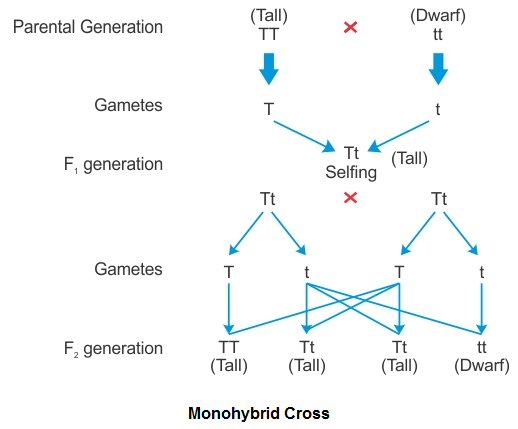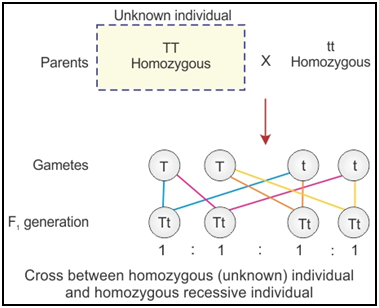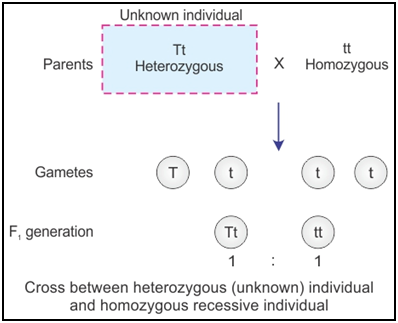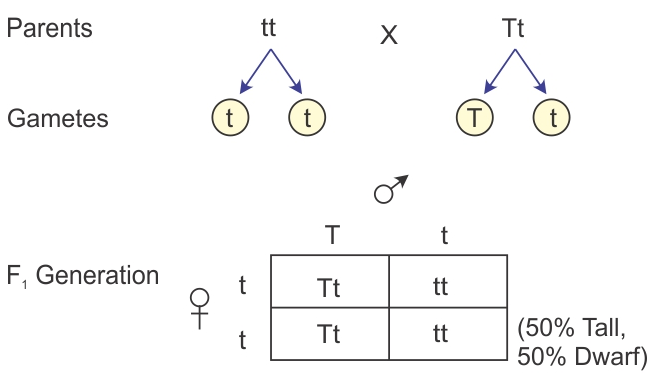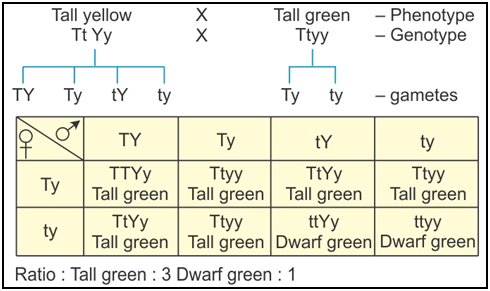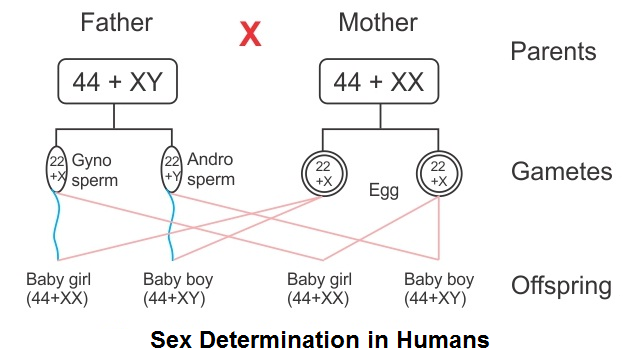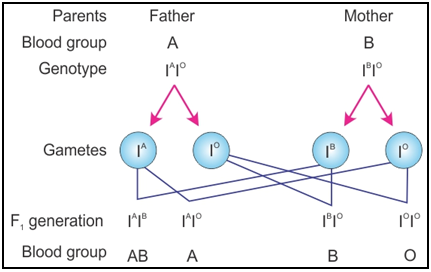Class 12-science NCERT Solutions Biology Chapter 4 - Principles of Inheritance and Variation
Principles of Inheritance and Variation Exercise 78
Solution 1
Advantages of selecting pea plant for experiment by Mendel:
- Study of pea plants is much simpler than that of animals.
- Pea plant is small and easy to grow and cross-breed artificially.
- The flowers are bisexual and hermaphrodite.
- Pea plant exhibits several contrasting characters.
- It exhibits clear cut differences in certain characters.
- It normally undergoes self-pollination but can be cross-pollinated manually.
- It is an annual plant and yields results in a year’s time, so it can be observed for many generations.
- Many generations of pea plants can be produced in a comparatively short span of time.
- Many varieties are available with observable alternative forms for a trait.
- Pea plant has several distinct varieties, each with visible contrasting characters which appear on separate chromosomes.
- Pure varieties of pea are available which always breed true.
- Large numbers of seeds are produced per plant which can be easily handled and cultivated.
Solution 2 (a)
Differences between dominance and recessive:
|
Dominance |
Recessive |
|
|
|
|
|
|
Solution 2 (b)
Differences between homozygous and heterozygous:
|
Homozygous |
Heterozygous |
|
• Pure for a trait and breeds true. |
• Seldom pure and produces offspring with different genotypes on selfing. |
|
• On selfing, progeny has same genotype and phenotype. |
• On selfing, progeny has three genotypes and mostly two to three phenotypes. |
|
• Both alleles for a character are similar. Example: TT or tt |
• Carries dissimilar alleles. Example: Tt |
|
• Can carry either dominant or recessive alleles but not both. |
• Has both dominant and recessive alleles. |
|
• Produces gametes of one type. |
• Produces gametes of two types. |
|
• Does not exhibit extra vigour. |
• Can exhibit extra vigour called hybrid vigour or heterosis. |
Solution 2 (c)
Differences between monohybrid and dihybrid:
|
Monohybrid |
Dihybrid |
|
• It is a cross between two pure organisms to study the inheritance of a single pair of alleles. |
• It is a cross between two pure organisms to study the inheritance of two pairs of alleles. |
|
• It produces a phenotypic monohybrid ratio of 3:1 in the F2 generation. |
• It produces a phenotypic dihybrid ratio of 9:3:3:1 in the F2 generation. |
|
• It produces a genotypic ratio of 1:2:1 in the F2 generation. |
• It produces a genotypic ratio of 1:2:1:2:4:2:1:2:1 in the F2 generation. |
|
• Inheritance of tall and dwarf characters is an example of a monohybrid cross. |
• Inheritance of yellow and round seed characters and green and wrinkled characters is an example of a dihybrid cross. |
Solution 3
When the organism is heterozygous for 3 loci, 8 types of gametes would be formed.
|
AaBbCc |
|||||||
|
ABC |
ABc |
AbC |
Abc |
aBC |
aBc |
abC |
abc |
The formula for calculating the gametes for a diploid organism can be deduced as
Number of gametes = 2n, where n is the number of loci.
In this case, the diploid organism is heterozygous for 4 loci.
By applying the formula, we get
2n = 24 = 2 × 2 × 2 × 2 = 16
Thus, a diploid organism heterozygous for 4 loci will form 16 types of gametes.
|
AaBbCcDd |
|||
|
ABCD |
AbCD |
aBCD |
abCD |
|
ABCd |
AbCd |
aBCd |
abCd |
|
ABcD |
AbcD |
aBcD |
abcD |
|
ABcd |
Abcd |
aBcd |
abcd |
Solution 4
The law of dominance states that when two different allelomorphic forms are present in an organism, only one expresses itself and may mask or prevent the expression of the other. The factor which expresses itself is called dominant, while the other which has shown its effect is termed recessive.
A monohybrid cross refers to hybridisation where two forms of a single trait are brought together.
Mendel’s experiment on a monohybrid cross:
- Mendel crossed a pure tall pea plant with a pure dwarf pea plant and obtained an F1 generation with all tall pea plants.
- He noticed that in the F1 generation, only one of the contrasting characters (tallness) appears and the others remain hidden (dwarf).
- The character which appears in F1 individuals is called the dominant character, and the character which is not expressed in F1 individuals is known as recessive.
- This shows that although both tall and dwarf plants were crossed, only the character of tallness was expressed. Tallness is dominant over dwarfness which remains unexpressed in the F1 generation.
- Thus, the above monohybrid cross proves the law of dominance put forth by Mendel.
- Later, Mendel continued his monohybrid cross and intercrossed the F1 hybrids and obtained the hybrids of the second filial generation (F2).
- In the F2 generation, the tall and dwarf plants were obtained in the ratio of 3:1 (phenotypic ratio).
- Genetically, this ratio was recognised in three groups of plants TT, Tt and tt with the ratio 1:2:1 (genotypic ratio).
Solution 5
A test cross is a cross between a dominant F1 hybrid and its homozygous recessive parent. It helps determine whether individuals exhibiting dominant character are genotypically homozygous or heterozygous.
Condition I: If the progeny obtained by crossing the F1 hybrid and its recessive parent are tall, then the F1 hybrid is homozygous tall (TT).
Condition II: If the progeny obtained by crossing the F1 hybrid and its recessive parent are 50% tall and 50% dwarf, then the F1 hybrid is heterozygous tall (TT).
Significance of the test cross:
- It helps identify the genotype of an unknown individual.
- Purity of the parents can be determined.
- It has wide application in plant breeding experiments.
Solution 6
A cross between a homozygous female and a heterozygous male has two possibilities:
Possibility I:
Homozygous dominant female: TT (Tall)
Heterozygous dominant male: Tt (Tall)
The progeny obtained by a cross between a homozygous dominant female and a heterozygous dominant male are tall.
Possibility II:
Homozygous recessive female: tt (Dwarf)
Heterozygous dominant male: Tt (Tall)
The progeny obtained by a cross between a homozygous recessive female and a heterozygous dominant male are 50% tall and 50% dwarf.
Solution 7
Solution 8
Linkage is a phenomenon of certain genes to stay together during inheritance through generations without any change or separation because of their presence on the same chromosome.
If two loci are completely linked (i.e. alleles are located closely on the same locus of a chromosome), then there would be no segregation of alleles due to complete linkage. The F1 generation would exhibit parental characteristics only.
However, if the two loci are incompletely linked, then segregation of alleles would occur partly and the F1 generation would exhibit parental and recombinant characteristics. The proportion of recombinants would be very less as compared to the parental combinations.
Solution 9
Contribution of T. H. Morgan to genetics:
- Discovered the basis for variations due to sexual reproduction
- Stated and established that genes are located on chromosomes
- Discovered linkage and distinguished linked and unlinked genes
- Proposed chromosomal theory of linkage
- Proposed chiasma type hypothesis showing that chiasma cause crossing over
- Found that frequency of recombination between two linked genes is directly proportional to the distance between the two
- Worked on sex-linked inheritance
- Gave the theory of inheritance
- Established the technique of chromosome mapping
- Observed and worked on mutation
Solution 10
A record of inheritance of certain genetic traits for two or more generations presented in the form of a diagram or family tree is called a pedigree. Analysis of traits in several generations of a family is called a pedigree analysis. It is used for human beings and domesticated animals.
Importance of pedigree analysis:
- Provides a strong tool which is used to trace the inheritance of a specific trait, abnormality or disease.
- Helps genetic counsellors to advise couples about the possibility of having children with genetic defects such as haemophilia, colour blindness, alkaptonuria, thalassaemia and sickle cell anaemia.
- Indicates that Mendel’s principles are also applicable to human genetics with modifications such as quantitative inheritance, sex-linked characters and linkage.
- Can indicate the origin of a trait and its flow in ancestors.
- Can indicate the harm caused by marriage between close relatives.
- Useful for extensive research in medical science.
Solution 11
Sex determination in human beings:
- In human beings, the chromosomal mechanism of sex determination is of the XX–XY type.
- In humans, the nucleus of each cell contains 46 chromosomes or 23 pairs of chromosomes. Of these, 22 pairs are autosomes and 1 pair is the sex chromosomes.
- Females possess two homomorphic sex chromosomes, XX.
- Males contain two heteromorphic sex chromosomes, XY.
- Females are homogametic and produce only one type of egg, (22+X).
- Males are heterogametic and produce two types of sperms, (22+X) and (22+Y).
- During fertilisation, if the sperm containing X chromosome fertilises the egg having X chromosome, then the resulting offspring would be a female (XX).
- If the sperm containing Y chromosome fertilises the egg having X chromosome, then the resulting offspring would be a male (XY).
- The sex ratio produced in the progeny is 1:1.
- This chromosomal mechanism of sex determination is called heterogamesis. It may be male heterogamety or female heterogamety.
Solution 12
Given, the father has blood group A, the mother has blood group B and the child has blood group O.
O is a recessive blood group. Therefore, the child will have homozygous recessive alleles IOIO. This is possible only when both his parents are heterozygous and has allele IO as one of their alleles. Hence, the genotype of the father will be IAIO and that of the mother will be IBIO.
The possible blood groups in the offspring of this couple are AB, A, B and O.
Solution 13
(a) Co-dominance: The alleles which are able to express themselves independently when present together in a heterozygote are called co-dominant alleles, and this phenomenon of inheritance is called co-dominance.
Example: AB blood group inheritance in humans where allele IA for A-type blood is co-dominant with its allele IB for B-type blood.
(b) Incomplete dominance: The phenomenon of inheritance where none of the contrasting characters in a pair are dominant is called incomplete dominance. The expression of the trait in the F1 hybrid is intermediate or a fine mixture of the expression of the two factors.
Example: In Mirabilis jalapa, the F1 hybrid produced by a cross between red and white flowers bears pink flowers.
Solution 14
Point mutation is the abrupt change in gene structure due to a change in a single base pair of DNA caused by inversion and substitution without changing the reading of subsequent bases.
Example: Sickle cell anaemia
- A substitution of a single nitrogen base guanine to adenine (GAG ® GUG) at the sixth codon of the β-globin chain of the haemoglobin molecules causes a change in the shape of the RBCs from biconcave discs to elongated, sickle-shaped structures.

- Normal RBCs are biconcave and flexible disc-like. This shape allows the cells to move through large and small blood vessels to deliver oxygen.
- Sickle-shaped RBCs are elongated, rigid and non-flexible. This causes the cells to stick to the blood vessel walls, causing a blockage which slows or stops the flow of blood resulting in sickle cell anaemia.
Solution 15
The chromosomal theory of inheritance was proposed independently by Walter Sutton and Theodore Boveri in 1902.
Solution 16
Autosomal disorders are caused by a defect in the gene present on autosomes. Sickle cell anaemia, Patau syndrome, phenylketonuria and Down’s syndrome are some autosomal genetic disorders.
Symptoms of sickle cell anaemia:
- The RBCs of the patient become elongated and curved (sickle-shaped) under low O2 tension.
- The sickle-shaped RBCs are destroyed more rapidly than the normal ones leading to anaemia.
Symptoms of Down’s syndrome:
- Broad forehead
- Short neck and flat hands
- Furrowed tongue and partially open mouth
- Stubby fingers and Mongolian type eyelid fold
- Retarded physical, psychomotor and mental development
- Deformities in the heart and other organs
- Underdeveloped gonads and genitalia

